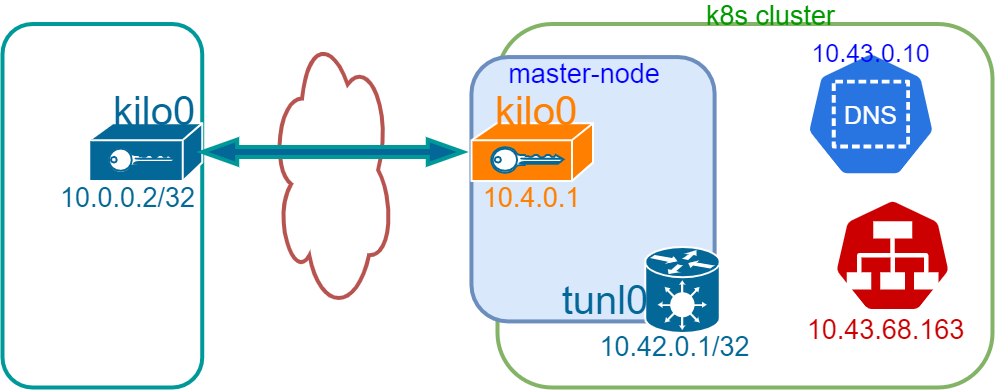Context and need
Some services on a k8s cluster are meant to be publicly accessible, others like dashboards administration consoles or monitoring systems do not. Depending on where your cluster is and whether your cloud provides private networks, the only way to access those consoles would be through an ingress endpoint: an inelegant and risky solution. Here is an WireGard based alternative my sensei taught me. It uses kilo, a WireGard overlay designed for Kubernetes by L. Marín (aka squat). With this set up, you’ll be able to access from your laptop, say longhorn dashboard, simply by visiting http://longhorn-frontend.longhorn-system.svc.cluster.local/dashboard
Requirements
Server
- WireGuard installed
- a public IP
- port 51820 opened
- firewall allowing postrouting in masquerade mode (
--add-masqueradewith firewalld see alsoMASQUERADEwith iptables)
Client
- WireGuard installed
- a public IP
openresolvinstalled (for DNS resolutions inside the VPN network)

Client keys generation
First we need a pair of keys
sudo -i
mkdir -p /etc/wireguard/keys && /etc/wireguard/keys
umask 077
wg genkey | tee privatekey | wg pubkey > publickey
For the rest of the tutorial, this will be the
- client’s secret key:
xxxxxxTheClientSecretKeyxxxxxxxx= - client’s public key:
xxxxxxTheClientPublicKeyxxxxxxxx=
Server setting
All you really need to do is to:
- install
kilowith one of the many available manifests (here I’ll use the one for k3s) - check that the relevant network interfaces have been created
- Define a peer using the client’s public key
- retrieve the server’s public key (to set the client up)
kubectl apply -n kube-system -f https://github.com/squat/kilo/blob/master/manifests/kilo-k3s.yaml
This should create two network interfaces (kilo0 and tunl0)
ip addr
......
22: kilo0: <POINTOPOINT,NOARP,UP,LOWER_UP> mtu 1420 qdisc noqueue state UNKNOWN group default qlen 1000
link/none
inet 10.4.0.1/16 brd 10.4.255.255 scope global kilo0
valid_lft forever preferred_lft forever
23: tunl0@NONE: <NOARP,UP,LOWER_UP> mtu 1430 qdisc noqueue state UNKNOWN group default qlen 1000
link/ipip 0.0.0.0 brd 0.0.0.0
inet 10.42.0.1/32 brd 10.42.0.1 scope global tunl0
valid_lft forever preferred_lft forever
Then, we create a kilo-peers.yml
apiVersion: kilo.squat.ai/v1alpha1
kind: Peer
metadata:
name: squat
spec:
allowedIPs:
- 10.0.0.2/32
publicKey: xxxxxxTheClientPublicKeyxxxxxxxx=
persistentKeepalive: 10
kubectl apply -n kube-system -f path/to/kilo-peers.yml
Finally, let’s get this server’s public keys using wg
sudo wg
interface: kilo0
public key: yyyyyyTheServerPublicKeyyyyyyyyy=
private key: (hidden)
listening port: 51820
peer: xxxxxxTheClientPublicKeyxxxxxxxx=
allowed ips: 10.0.0.2/32
client setting
Now that we have a server public key, we can create a kilo0 interface by editing /etc/wireguard/kilo0.conf. Concerning AllowedIPs, those are the default CIDR of
- pods:
10.42.0.0/24 - services:
10.43.0.0/16 - kilo:
10.4.0.1/16
[Interface]
PrivateKey = xxxxxxTheClientSecretKeyxxxxxxxx=
Address = 10.0.0.2/32 # this will be your subnet in this network
DNS = 10.43.0.10 # DNS server's IP in the cluster
# server
[Peer]
PublicKey = yyyyyyTheServerPublicKeyyyyyyyyy=
Endpoint = 111.11.11.111:51820
AllowedIPs = 10.42.0.0/24, 10.43.0.0/16, 10.4.0.1/16
persistentKeepalive = 12
persistentKeepaliveis indispensible. Without it, no handshake will ever happen
Let’s then start the interface
sudo wg-quick up kilo0
and check that everything is in order
ip addr
......
57: kilo0: <POINTOPOINT,NOARP,UP,LOWER_UP> mtu 1420 qdisc noqueue state UNKNOWN group default qlen 1000
link/none
inet 10.0.0.2/32 scope global kilo0
valid_lft forever preferred_lft forever
Test
Find any service (or pod, for that matter) and try to access it with your web browser.
kubectl get svc -A
....
longhorn-system longhorn-frontend ClusterIP 10.43.68.163 <none> 80/TCP
....
With this set up, I can easily access longhorn’s dashboard by visiting either:
- http://longhorn-frontend.longhorn-system.svc.cluster.local
- http://http://10.43.68.163
Troubleshooting
First check that both ends managed to perform a handshake. Typically, you should see that
- both
- the server has identified the client’s public IP
- public keys match
Server
sudo wg
interface: kilo0
public key: yyyyyyTheServerPublicKeyyyyyyyyy=
private key: (hidden)
listening port: 51820
peer: xxxxxxTheClientPublicKeyxxxxxxxx=
endpoint: 22.222.22.2:9652
allowed ips: 10.0.0.2/32
latest handshake: 5 seconds ago
transfer: 1.18 MiB received, 20.94 MiB sent
Client
sudo wg
interface: kilo0
public key: xxxxxxTheClientPublicKeyxxxxxxxx=
private key: (hidden)
listening port: 43573
peer: yyyyyyTheServerPublicKeyyyyyyyyy=
endpoint: 111.11.11.111:51820
allowed ips: 10.42.0.0/24, 10.43.0.0/16, 10.4.0.1/32
latest handshake: 1 minute, 16 seconds ago
transfer: 21.58 MiB received, 1.22 MiB sent
persistent keepalive: every 12 seconds
If this is the case and you are still unable to access a cluster’s service, try to ping the server’s kilo0 CIDR.
ping 10.4.0.1
PING 10.4.0.1 (10.4.0.1) 56(84) bytes of data.
64 bytes from 10.4.0.1: icmp_seq=1 ttl=64 time=40.9 ms
64 bytes from 10.4.0.1: icmp_seq=2 ttl=64 time=42.2 ms
64 bytes from 10.4.0.1: icmp_seq=3 ttl=64 time=42.7 ms
64 bytes from 10.4.0.1: icmp_seq=4 ttl=64 time=42.3 ms
If you do not get an answer, check on the server that kilo0 is up and running. If you do get an answer, the problem is probably caused by your firewall not allowing postrouting
